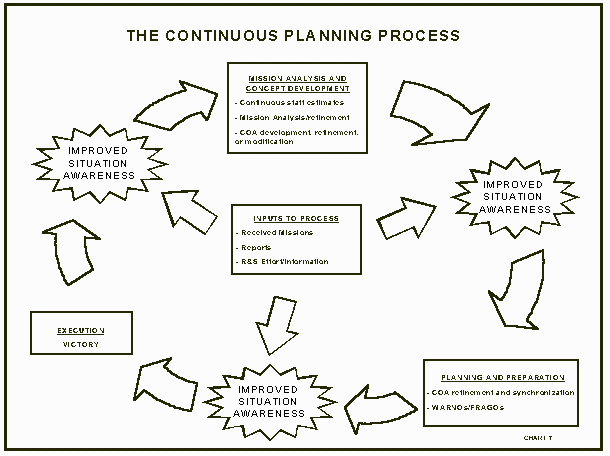CHAPTER
V
Refining the Plan
As previously stated, the MDMP is a continuous process; it never really ends. Remember, the original order was probably published with approximately 30-percent situational awareness with respect to the enemy, terrain, and friendly situation (see Chart 4). As the situation develops, and your situational awareness improves, changes to the original plan are usually imperative. If necessary changes are not made, you are fighting the plan, not the current situation. Implementing changes to an order that has already been issued is no easy task, especially in a time compressed environment. To alleviate this problem, there are numerous tools available to assist you in this effort. These tools are an aggressive reconnaissance and surveillance (R&S) effort, continuous staff estimates, the MDMP itself, and warning orders (see Chart 7 below).

Your R&S effort must be aggressive and continuous. You must constantly seek to attain as much information about the enemy as possible. You developed the original SITEMPs early in the planning process, and it was probably only a best guess. Once collected, information generated by your R&S efforts must be analyzed to confirm or deny your initial enemy SITEMPs. This information may ultimately result in changes to your SITEMPs, which may then create changes to your selected COA.
If changes to the selected COA are required, the COA must be quickly refined, developed, and re-synchronized as necessary. Minor changes may be incorporated without much problem. Major changes will require more time and effort. In this situation, you may have to use the MDMP, or, more appropriately, one of the abbreviated forms of the MDMP. The techniques and procedures already discussed still apply. To facilitate these last-minute changes, staff officers must constantly evaluate, update, and access their respective staff estimates, and their impact on the original plan. For example, a simple change in the personnel or maintenance status of a unit may have a significant impact on task organization, main and supporting efforts, as well as subordinate unit task/purpose. Required changes can only be identified if staff officers are constantly evaluating and adjusting, as necessary, their initial staff estimates.
Once necessary changes are identified, these changes must be rapidly and clearly transmitted to subordinate units. Normally these changes will be communicated in the form of a WARNO or FRAGO. Depending on the significance of the change, this information may be transmitted verbally during a commander's conference call, or in writing. WARNOs and FRAGOs must be constantly used to alert subordinate units of impending changes, and to facilitate maximum troop-leading time.
TECHNIQUES:
- Constantly review and adjust, as necessary, your CCIR. These CCIR drive the R&S effort.
- Your R&S effort must constantly seek to gain as much information about the enemy as possible in an effort to answer the commander's PIR. This information must be evaluated and incorporated into the current SITEMPs.
- Staff officers must also constantly update their staff estimates and assess potential impacts on the current plan/situation.
- If changes are necessary to the current plan, use one of the abbreviated forms of the MDMP to refine, develop, and synchronize the modifications as necessary.
- Use multiple FRAGOs and WARNOs to communicate changes as necessary.
- Plan for potential refinements or decision points. Issue these branch plans with the original operations order. Once information becomes available that supports the appropriate decision point, execute the branch plan with a FRAGO.

 Chapter
IV - Accelerating the Decision-Making Process
Chapter
IV - Accelerating the Decision-Making Process Chapter
VI - Home-Station Training
Chapter
VI - Home-Station Training
|
NEWSLETTER
|
| Join the GlobalSecurity.org mailing list |
|
|
|

